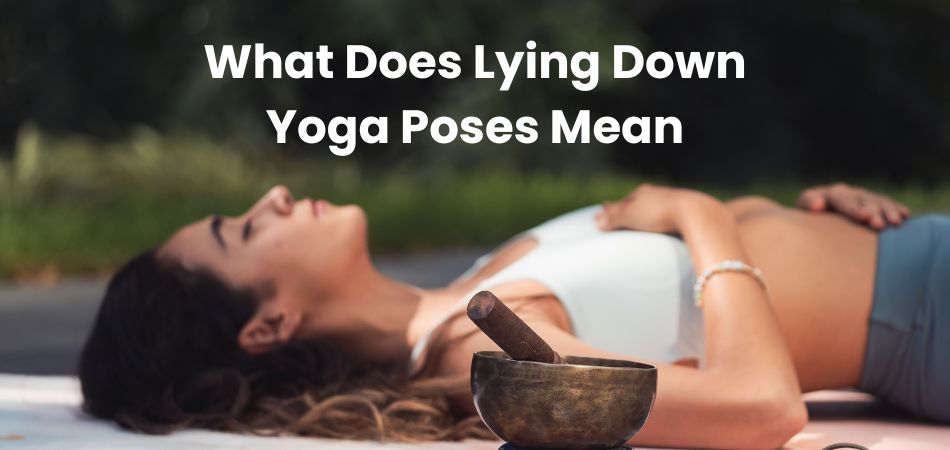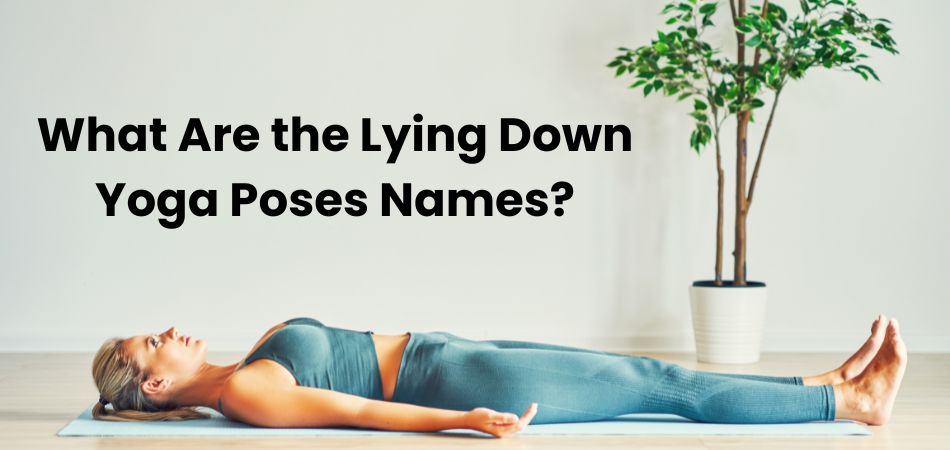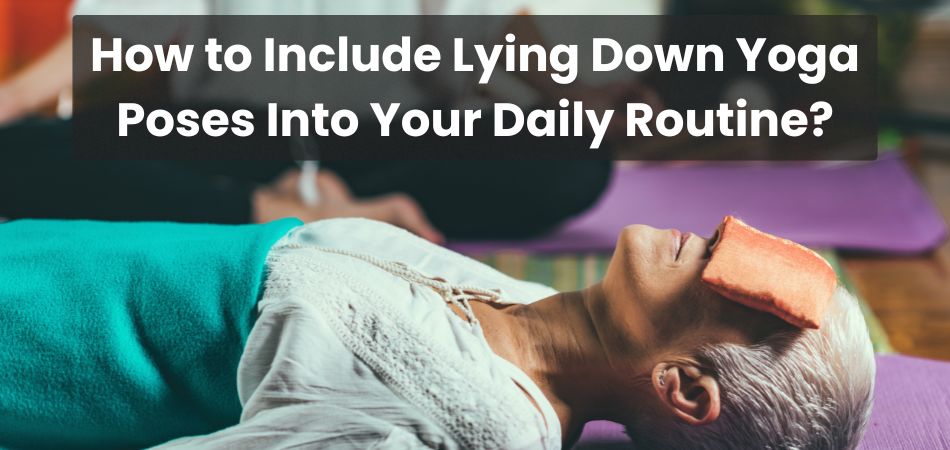Yoga is a journey of balance, mindfulness, and self-care. Among its many practices, lying down poses offer an excellent opportunity to relax deeply while enhancing flexibility and alignment.
Whether you’re new to yoga or a seasoned practitioner, these poses provide restorative benefits for the body and mind. But what are the lying down yoga poses names?
Lying down yoga poses include Corpse Pose (Savasana), Plow Pose (Halasana), Reclining Bound Angle Pose (Supta Baddha Konasana), Bridge Pose (Setu Bandhasana), Wind-Relieving Pose (Pavanamuktasana), and others, each offering particular benefits for relaxation, flexibility, and strength.
Are you ready to explore the full potential of these soothing poses? Read on to learn their names, benefits, and how to correctly implement them.
What Does Lying Down Yoga Poses Mean?
Lying down yoga poses, also known as supine poses or reclining asanas, are postures performed while the body is positioned horizontally on the ground. These poses can vary from deeply restorative positions to more active stretches, offering a diverse range of benefits for both beginners and advanced yoga practitioners.

They often focus on relaxation, improving flexibility, and aligning the body without the strain of standing or balancing. The meaning of lying down yoga poses extends beyond their physical positioning. They symbolize surrender and grounding, helping practitioners connect with the Earth while releasing tension from the muscles and mind.
These poses are commonly included in yoga sequences for cool-downs, restorative practices, or therapeutic sessions aimed at healing and rejuvenation. They are ideal for calming the nervous system and promoting mindfulness.
Adding lying down poses into your routine can be transformative. Whether you seek physical relief, mental clarity, or emotional balance, these poses provide a foundation of support and relaxation that enhances overall well-being.
Laying Down Yoga Pose: What is It Called?
A laying down yoga pose is generally referred to as a supine pose or reclining asana. These poses are performed with the body positioned horizontally on the ground, offering a sense of grounding and relaxation.
Common examples include Savasana (Corpse Pose), a deeply restorative pose, and Supta Baddha Konasana (Reclined Bound Angle Pose), which opens the hips and calms the mind. These poses are versatile, serving as a foundation for gentle stretches, restorative sequences, or even dynamic movements.
The name of each lying down pose often reflects its purpose or the part of the body it engages. For instance, Supta Matsyendrasana (Reclined Spinal Twist) is designed to release tension in the spine. Exploring these asanas can help deepen your yoga practice by encouraging relaxation and physical alignment.
What Are the Lying Down Yoga Poses Names?
Lying down yoga poses are a cornerstone of relaxation and physical alignment in yoga practice. Each pose has a particular purpose, helping to stretch, strengthen, or calm the body and mind. Here, we explore the names and significance of some popular lying down yoga poses and their benefits.

1. Corpse Pose (Savasana)
Corpse Pose is the ultimate relaxation pose, typically practiced at the end of a yoga session. It involves lying flat on your back, with arms at your sides, palms facing up. This pose helps to calm the mind, reduce stress, and integrate the benefits of your practice.
2. Plow Pose (Halasana)
Halasana, or Plow Pose, involves rolling the legs over the head while lying on your back. This pose stretches the spine and shoulders and improves flexibility. It also stimulates the thyroid and enhances overall circulation.
3. Reclining Bound Angle Pose (Supta Baddha Konasana)
This pose, also known as Reclined Butterfly Pose, gently opens the hips and stretches the inner thighs. By lying on your back with feet together and knees falling open, it provides a restorative stretch. It is especially effective for relieving stress and calming the nervous system.
4. Bridge Pose (Setu Bandhasana)
Bridge Pose involves lifting the hips toward the sky while the shoulders and feet remain grounded. It strengthens the back, glutes, and hamstrings while opening the chest. This pose energizes the body and alleviates lower back tension.
5. Wind-Relieving Pose (Pavanamuktasana)
Wind-Relieving Pose helps to release trapped gas and improve digestion. It involves drawing the knees to the chest while lying on your back. This pose is gentle yet effective for soothing abdominal discomfort.
6. Child Pose (Balasana)
While not strictly a lying down pose, Child Pose offers a deeply restorative experience. It involves folding the torso over the thighs while stretching the arms forward. This pose relieves tension in the back and promotes relaxation.
7. Legs-Up-The-Wall Pose (Viparita Karani)
Legs-Up-The-Wall Pose is a passive inversion that involves resting your legs against a wall while lying on your back. It improves circulation, reduces swelling in the legs, and calms the nervous system. This pose is perfect for unwinding after a long day.
8. Cobra Pose (Bhujangasana)
Cobra Pose involves lifting the chest while keeping the legs and pelvis grounded, creating a gentle backbend. This pose strengthens the spine, stretches the chest, and improves posture. It also helps alleviate stress and fatigue.
Benefits of Lying Down Yoga Poses in Your Body
Lying down yoga poses are not only deeply relaxing, but they also provide a wide range of physical benefits. These poses help improve flexibility, alleviate tension, and promote overall body alignment. Below are the key benefits of including lying down yoga poses into your practice.
1. Improves Flexibility
Lying down yoga poses gently stretch various muscle groups, enhancing overall flexibility. Poses like Supta Baddha Konasana and Reclining Bound Angle Pose focus on opening the hips and stretching the inner thighs. These stretches release tightness in the muscles, increasing the range of motion. Over time, these poses help prevent injury and improve posture by lengthening and loosening muscles.
2. Relieves Stress and Tension
Lying down yoga poses are incredibly effective at promoting relaxation and reducing stress. Poses such as Savasana and Child Pose allow the body to release built-up tension. These positions stimulate the parasympathetic nervous system, which promotes deep relaxation. As a result, they reduce cortisol levels, helping to alleviate anxiety and mental fatigue.
3. Enhances Circulation
Many lying down yoga poses, like Legs-Up-The-Wall Pose, encourage better circulation by strengthening the legs or promoting gentle inversions. By improving blood flow to the heart, these poses help reduce swelling and improve overall vascular health. This increase in circulation also aids in the delivery of oxygen and nutrients to vital organs. Better circulation contributes to better recovery and general well-being.
4. Strengthens Core and Lower Body
Some lying down poses, such as Bridge Pose, engage and strengthen the core, glutes, and lower back. These muscles are essential for maintaining good posture and stability. Regular practice of these poses can improve overall strength and balance, supporting the spine and preventing lower back pain. Strengthening the lower body through these asanas also helps in activities that require mobility and endurance.
5. Promotes Better Sleep
Practicing lying down yoga poses, particularly Savasana or Wind-Relieving Pose, can promote deeper, more restful sleep. These poses activate the relaxation response in the body, which reduces physical and mental tension. By calming the nervous system, these poses help lower stress levels that often interfere with sleep. Incorporating them into your evening routine can lead to more restorative sleep and better overall health.
How to Include Lying Down Yoga Poses Into Your Daily Routine?
Your physical and mental well-being can be profoundly improved by incorporating lying down yoga poses into your daily routine. Whether you’re new to yoga or a seasoned practitioner, these poses can be easily added to your day. Below are simple ways to include these soothing and restorative poses into your everyday practice.

1. Start Your Day with Savasana
Begin your morning by practicing Savasana to set a peaceful tone for the day ahead. Lie on your back with your arms by your sides and focus on deep, slow breathing. This gentle pose helps to center your mind and body, preparing you for whatever the day brings.
2. Use Lying Down Poses for a Midday Break
If you’re feeling stressed during the day, incorporate some lying down poses like Child’s Pose or Wind-Relieving Pose. These poses allow you to pause and reset, reducing mental fatigue. Taking just 5–10 minutes to stretch and breathe can rejuvenate you for the rest of the day.
3. Add Reclining Poses to Your Warm-Up Routine
You can start your yoga session with lying down poses like Supta Baddha Konasana or Reclining Spinal Twist to ease into deeper stretches. These poses gently open the body and prepare it for more intense movements. Including them in your warm-up helps increase flexibility and reduce the risk of injury.
4. Integrate Them into Your Evening Routine
Incorporate Legs-Up-The-Wall Pose or Bridge Pose at the end of your day to promote relaxation before bed. These restorative asanas reduce stress and help release tension accumulated throughout the day. Ending your evening with these poses can signal to your body that it’s time to wind down and prepare for restful sleep.
5. Use Them During Stressful Moments
Lying down poses are perfect for moments when you feel overwhelmed or stressed. A few minutes of Savasana or Reclining Bound Angle Pose can help ground you and calm your mind. These poses are ideal for quick breaks when you need to refocus and regain your sense of calm.
6. Create a Bedtime Ritual
Make lying down yoga poses a key part of your nighttime routine to promote better sleep. Practicing poses like Supta Matsyendrasana and Viparita Karani can help release tension and prepare your body for sleep. A consistent nighttime yoga practice will improve your sleep quality and overall well-being.
7. Practice Mindful Breathing Along with the Poses
As you practice each lying down pose, focus on mindful breathing to deepen the benefits. Breathing slowly and consciously while in poses like Child’s Pose or Cobra Pose helps relax the nervous system. This combination of breath and movement enhances the restorative effects of each pose, helping you achieve greater relaxation.
When Is the Best Time to Practice Lying Down Yoga Poses?
The best time to practice lying down yoga poses depends on your goals and daily schedule. In the morning, these poses can serve as a gentle way to wake up your body, improve flexibility, and set a calm tone for the day.
Starting with a restorative pose like Savasana or Supta Baddha Konasana can help you center your mind and body before engaging in more active activities. Early practice can energize you and prepare your muscles for the day ahead.
Lying down yoga poses can also be incredibly effective during midday breaks, especially when you need to recharge. Taking 5-10 minutes for poses like Wind-Relieving Pose or Child’s Pose can reduce stress, alleviate tension, and reset your mental state. These poses offer a moment of calm, enhancing focus and productivity for the remainder of your workday.
The best time to practice lying down poses, however, may be in the evening. Incorporating them before bed can help relax your muscles, relieve the day’s stress, and improve sleep quality. Poses like Legs-Up-The-Wall Pose and Bridge Pose are perfect for preparing your body to unwind and rest peacefully.
Frequently Asked Questions (FAQs)
Lying down yoga poses offer many benefits for both the body and mind, making them a great addition to any routine. If you’re new to these poses, you might have a few questions about how to best incorporate them into your practice. Here are answers to some frequently asked questions that can help guide you as you explore lying down yoga poses.
1. Can Lying Down Yoga Poses Be Practiced by Beginners?
Yes, lying down yoga poses are ideal for beginners because they don’t require advanced flexibility or strength. These poses allow you to focus on breathing and alignment while gently stretching the body. They provide a great foundation to build your practice from the ground up.
2. How Long Should I Hold Lying Down Yoga Poses?
It’s recommended to hold each lying down yoga pose for about 3-5 minutes, depending on your comfort level. This duration allows enough time to relax into the stretch and feel the full benefits. However, always listen to your body and adjust the time based on how you feel.
3. Can Lying Down Yoga Poses Help With Back Pain?
Yes, many lying down yoga poses can help alleviate back pain by promoting gentle stretching and strengthening of the muscles. Poses like Bridge Pose and Reclining Spinal Twist help release tension in the lower back. These poses improve alignment and increase flexibility, which can help reduce discomfort over time.
4. Do I Need Props to Practice Lying Down Yoga Poses?
Props like blankets, pillows, or yoga blocks can increase comfort and support during lying down yoga poses. Using props can help you maintain proper alignment and deepen your stretches without straining your body. While props aren’t necessary, they can make the practice more accessible and relaxing.
5. Is It Okay to Practice Lying Down Yoga Poses Daily?
Yes, practicing lying down yoga poses daily is perfectly safe and can be beneficial for maintaining flexibility and relaxation. These poses are gentle on the body and can be a great way to unwind after a long day. Incorporating them regularly will support both your physical and mental well-being.
Final Words
Including lying down yoga poses into your routine can offer a wealth of benefits, from improving flexibility to relieving stress. These poses provide a perfect way to unwind, stretch, and reconnect with your body.
If you’re wondering what are the lying down yoga poses names, knowing their purpose and how to practice them can enhance your overall yoga experience.
Whether you’re using them for relaxation, injury recovery, or strengthening, these poses are a great addition to any practice. With regular practice, you’ll notice increased relaxation, better posture, and a more balanced mind and body.
